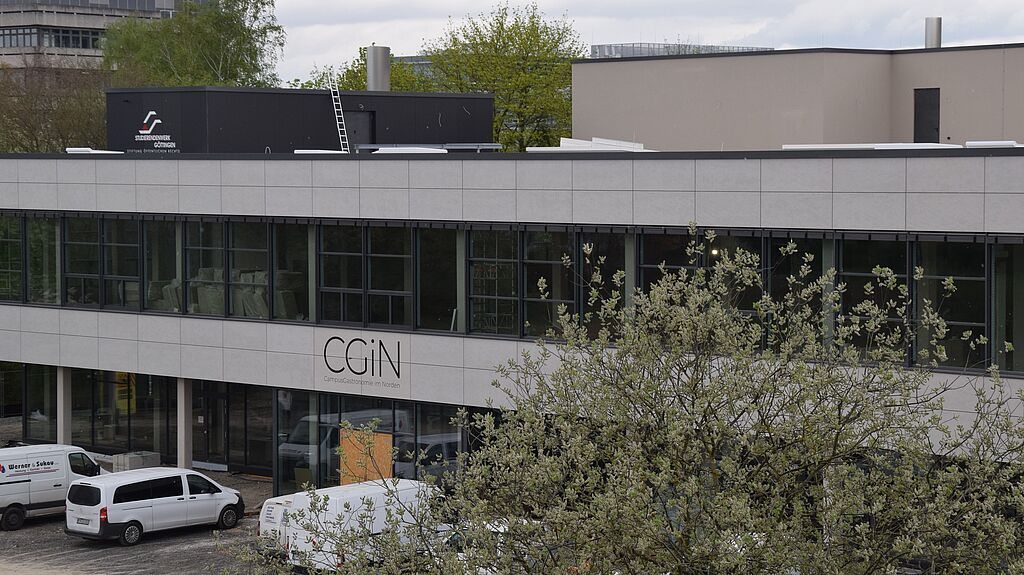Energy concept CGiN
Energy demand
Comparison of energy requirements of the old Nordmensa / CGiN
The canteen operation in future efficiency orientation, including the enlarged construction volume and far higher numbers of meals, will require an energy demand of
Total energy requirement CGiN 2,000 MWh/a
Of which levelled to the new building
Heat 1,850 MWh/a
Electricity 150 MWh/a
with own power generation / utilisation
The operation of the canteen in the old building has an energy requirement of
Total energy demand of old building Nordmensa 1.800 MWh/a
of which according to the 2015 energy audit report
Heat 950 MWh/a
Electricity 860 MWh/a
of which the majority is electrical energy used for cooking
Energy generation
Combined cooling, heating and power (CCHP): The CGiN's energy supply is realised through the use of combined cooling, heating and power (CCHP) modules. This system simultaneously produces electricity, heat (heating, hot water, steam for the kitchen and scullery) and cooling, which makes it much more efficient and thus makes an important contribution to the energy transition. Compared to conventional gas-fired power plants, which have an efficiency of around 50 %, CCHP technology utilises the heat generated more efficiently, with efficiencies of over 90 %. This not only increases efficiency, but also improves the environmental and climate impact. The heat generated is also used outside the canteen to supply residential complexes (Lutterterrassen, Kellnerweg, guest house) with hot water and heating, which ensures holistic and sustainable energy utilisation. In terms of efficient energy utilisation, the integration of the CCHP units as a combined heat and power system is significantly enhanced by the use of waste heat from the CCHP units' electricity production for cooling via absorption cooling (see below).
No other system can currently achieve a better utilisation of the energy used. The process heat required for cooking in the canteen is generated by a combined heat and power unit with maximum fuel utilisation, which also uses the low-temperature exhaust heat.
Absorption refrigeration technology: The rooms (dining rooms, kitchen, scullery) are cooled by absorption refrigeration technology using waste heat (see below). This minimises the use of electrical energy compared to conventional chillers.
Use of CO2 as a natural refrigerant: Process cooling for food refrigeration with deep-freezing etc. is sustainable and climate-neutral thanks to the use of CO2 as a natural refrigerant with a Global Warming Potential (GWP) of zero. The (inevitably generated) waste heat from the refrigeration processes for deep-freezing and normal refrigeration is utilised almost completely; in several stages, with high-temperature decoupling and utilisation of the low-temperature (usually unused) portion.
Waste heat utilisation: Ventilation systems – The waste heat generated from, among other things, the waste heat from cooking in the kitchen or the heat brought in by people in the canteen area is utilised effectively in various stages, with a particularly high heat recovery rate of up to over 80 % being achieved in the ventilation systems.
Refrigeration – see absorption refrigeration technology
Waste heat from process heating – Waste heat from the process heat generation of the CCHP units, steam generation, etc. is used to feed a cold-heat network for the heating supply of neighbouring residential complexes (Lutterterrassen, Kellnerweg, guest house) via local heat pumps. These measures not only reuse energy efficiently, but also enable sustainable heating of the aforementioned residential complexes, which contributes to holistic and resource-saving energy utilisation
Energetic qualification
The objective was to make the new building fit for the future in terms of its energy requirements, sustainability, climate compatibility and use of resources.
"Better than KfW 40": The CGiN is set up as a highly energy-efficient building with the energy qualification "better than KfW 40" (also known as EH 40). The KfW 40 label means that the energy footprint of the new Nordmensa is only 40% of that of a comparable standard building of the same configuration. This energy efficiency rating relates both to the thermal insulation of the building envelope and to the energy technology equipment required to operate the canteen.
Federal funding due to particularly high energy efficiency: The concept and execution led to a funding approval from the Federal Ministry for Economic Affairs and Climate Protection due to the particularly high energy efficiency. The funding approval contributes significantly to the subsequent economic operation of the canteen (criteria for funding approval include low energy consumption (< KfW 40) as well as the avoidance of CO2 and other greenhouse gas emissions).
Overfulfilment of the legal requirements of the GEG: The building as a whole, thermal insulation of the building envelope, efficiency of the system technology of the technical equipment, falls well below the KfW 40 standard, thus far exceeding the legal requirements of the Building Energy Act (GEG) and the stricter framework conditions of the BEG (federal subsidy for efficient buildings). All this despite the partial integration of existing building fabric.
Highly efficient in all areas: The technical equipment – heating, cooling, ventilation, heat recovery – is geared towards high efficiency in all areas. This also applies to the "smallest" sub-systems. The complex interaction of the systems with each other is integrated and coordinated, as is required, for example, for waste heat utilisation as a whole.
Conclusion
The energetic orientation of the operation of the CGiN is by no means backward-looking; on the contrary, the overall "building and technology" system is highly efficient, energy-saving and future-orientated - despite the use of fossil fuels, which can be replaced by hydrogen technology if the framework conditions are right. There is also nothing to prevent the system from being operated with biomethane (although this is expressly not the aim at present, as the production of biomethane also needs to be critically analysed).
The same applies to the increased use of electrical energy (e.g. for cooking, cooling, etc.). Renewable electrical energy will not be exclusively available in the coming years. Today and for the foreseeable future, all electricity consumption is associated with climate-damaging emissions – including the use of heat pumps. Generation using CCHP units is just as harmful, but less so in the balance sheet due to the multiple best utilisation of the natural gas, biogas or, in the future, hydrogen fuel used.
Substituting electricity generation, generated decentrally, also relieves the local and higher-level grid structure. From a local perspective, this is of particular importance with increasing electrification. Relieving the power lines for the increased transport from the windy north to the south are also side effects, which only become noticeable in the sum of decentralised systems, but which provide a small anchor point here.
The decentralised simultaneous generation of electricity for own use in the canteen and the halls of residence as well as heat for cooking, heating and cooling, heating the halls of residence in addition to the canteen, partly with waste heat, represents the best solution – both in terms of energy and environmental/climate relevance.
Why are no heat pumps used?
The demand to avoid the use of fossil fuels for the CGiN through the use of heat pumps is countered by a lack of framework conditions in terms of system technology. Although their use is possible in theory, in practice the use of heat pumps suitable for high-temperature applications is currently being planned in some places in Germany, but is still at the development stage. This is even more the case if a higher temperature level is required, such as for steam generation or absorption cooling.
Both food preparation and dishwashing (around 38,000 pieces of crockery a day) with hot water supply require a high temperature level in order to be able to fulfil the tightly timed requirements of food preparation (and cleaning) in canteen operation. High-temperature heat pumps are usually those that can provide heating water temperatures of over 65°C up to around 80°C. This temperature level is not sufficient for hot water supply. This temperature level is not sufficient for the requirements of canteen operation.
Supplementary notes on the use of high-temperature heat pumps
- Refrigerant heat pumps
Refrigerants commonly used today are generally not unproblematic in terms of their environmental compatibility. Some of them can be labelled as harmful to the climate, flammable or toxic, are mixed with more or less problematic substances and contain, for example, PFAS (perfluorinated and polyfluorinated alkyl compounds) – long-lasting, indestructible, toxic. Or they are to be categorised as "hazardous" and special precautions are required, as is the case for the well-proven refrigerant ammonia, NH3.
- Efficiency-limiting aspects
It is not essential to generate steam for food preparation; this can be done electrically. The provision of steam makes it possible to cover high power demands, as required in food preparation and post-treatment, without drawing this power from the electrical supply system at very high peak loads. Each peak load demand provokes (in its summation) an immediate provision of power in the electrical supply network. As a rule, this must be covered by peak-load power plants (even in the case of a high renewable supply situation). However, cooling via absorption refrigeration can only be realised economically at high temperatures >= 90°C – as is the case with CCHP heat, which generates steam and heating energy in parallel.
- Heat sinks / sources
The use of heat pumps requires reliable heat sinks or heat sources.
- - Air as a heat sink
Such heat sinks or heat sources are "not just there", except for the ambient air. Environmental heat from air is available in sufficient quantities. However, it is unfortunately less suitable when outside temperatures drop to colder levels, usually when heat is required in greater quantities. The heat pump process is based on the laws of physics and thermodynamics and loses its major advantages of very high efficiency under "unsuitable" conditions. Due to its physical properties, air as a heat transfer medium can only be utilised to a limited extent, combined with a high level of equipment and cost-intensive heat recovery – justifiable for low-temperature heating systems in residential buildings. Air as a heat source must be categorised as "unsuitable" for canteen operation.
- - Geothermal energy
Geothermal energy, close to the surface, up to around 200 m, even 400 m under special conditions, or as deep geothermal energy, sunk down to several thousand metres, offers good conditions for the use of heat pumps. Deep geothermal energy requires long-term exploration, testing and authorisation procedures; for this reason, the use of this most suitable heat source, which can also be used with direct heat extraction, is ruled out. Deep boreholes up to approx. 180 m require the prospecting of a so-called geothermal field, which also requires lengthy geological and thermal investigations in advance to ensure a permanent heat extraction capacity – apart from the clarification of the land ownership situation and its rights of use, etc. This is not possible in the area of the canteen area. This also cannot (or could not) be realised in the area around the cafeteria, and even today the realisation of a geothermal field with several hundred deep boreholes does not appear to be feasible.
- - Waste heat
In principle, waste heat is ideally suited as a heat source or sink. However, waste heat must be available or be brought in from external areas. Waste heat is not available locally from the Studentenwerk's properties. Waste heat generated within the cafeteria is utilised extensively, but must first be introduced as an expense.
Status: 30 January 2024
Information provided by Dipl. Ing. Günther Geese; GEESE Beratende Ingenieure, and Studentenwerk Göttingen, Facility Management Department.
[Translated with DeepL]





